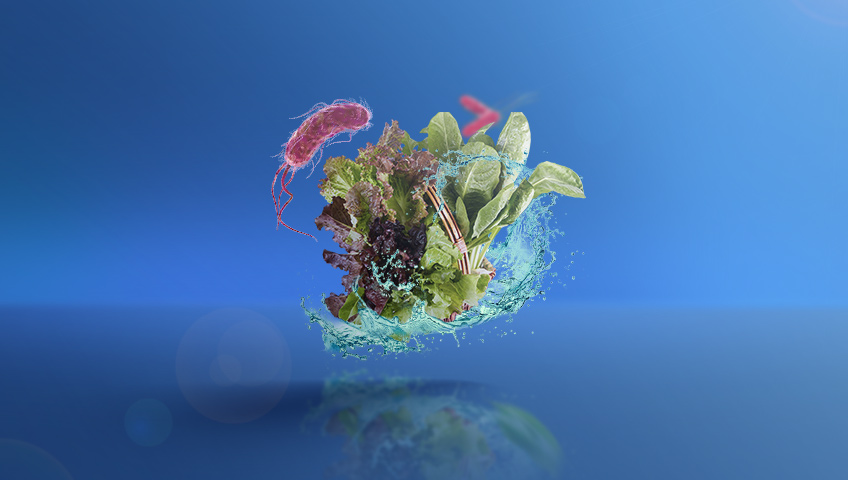2025.11.12
Fresh vegetables are rich in vitamins, minerals, fiber, antioxidants, and other essential nutrients, playing a vital role in maintaining health and strengthening the immune system. However, before these products reach our kitchens, they may be exposed to various contaminants during planting, cultivation, harvesting, transportation, and distribution stages, turning them into potential sources of microbial and parasitic contamination. In our country, due to the possible use of animal and human fertilizers in farms, lack of proper supervision over irrigation water quality, and the presence of domestic and wild animals in agricultural fields, there is a risk of contamination with bacteria such as Salmonella, Escherichia coli, Listeria, parasite eggs that cause hydatid cyst disease and etc. Consuming vegetables raw such as in fresh herb platters, seasonal salads, food garnishes, or inside sandwiches without proper disinfection can lead to various gastrointestinal infections and foodborne illnesses, including infectious diarrhea, typhoid, cholera, paratyphoid, and others. It may even contribute to the outbreak of epidemics within communities. Therefore, ensuring proper hygiene and sanitization of vegetables before raw consumption is essential for protecting family health. To ensure the safety of vegetables, a multi-step method is recommended, including initial cleaning, parasite removal, microbial disinfection and final rinsing:
Steps for sanitizing common raw vegetables include the following:
- Initial cleaning
In this step, physical impurities such as soil, insects, wilted or decayed leaves, and yellowed parts are removed from the vegetables:
- For fresh herbs such as basil, parsley, coriander, chives, scallions, radishes, and similar greens: after trimming and removing wilted, damaged, or yellow parts, immerse the herbs in a clean water-filled container and gently swirl them to dislodge dirt, soil residues, insects, and surface contaminants.
- For vegetables like lettuce, cabbage, and similar leafy greens: remove the outer leaves that are more likely to be contaminated with dust, soil, pesticide residues, and environmental contact. Also, eliminate damaged, bruised, or cut parts, as these areas are more susceptible to microbial growth due to compromised tissue. Then, separate the leaves and immerse them in clean water, gently agitating them to remove any adhering dirt or debris.
- For rough-surfaced vegetables like potatoes or root vegetables such as carrots, turnips and etc : use a soft brush to clean them under running water. Brushing helps remove soil and contaminants lodged in surface crevices.
- Gently remove the vegetables from the water and place them in an appropriate strainer or basket.
- Parasite removal (egg detachment)
The goal of this step is to eliminate parasite eggs that may be stuck to vegetable surfaces and cannot be removed by plain rinsing:
In a suitable container (according to the amount of vegetables), add about 1 to 2 drops of dishwashing liquid per liter of clean water. To avoid overuse, you can use a regular dropper commonly available at home or pharmacies. Gently stir the water to create a mild lather. Then, immerse the pre-washed vegetables into the soapy water and leave them for about 5 minutes. The dishwashing liquid reduces the surface tension and slipperiness, weakening the adherence of parasite eggs and causing them to separate and settle at the bottom of the container. Carefully remove the vegetables from the solution, discard the soapy water, and rinse both the container and the vegetables thoroughly with clean water to remove any remaining soap and parasite eggs.
- Microbial disinfection
At this stage, the goal is to eliminate any remaining microorganisms on the vegetable surfaces:
To disinfect the vegetables, dissolve 1 gram of 70% calcium hypochlorite powder (equivalent to half a teaspoon) in 5 liters of clean water in a suitable container. Stir well to prepare the disinfectant solution. Then, immerse the parasite-free vegetables in the solution for 5 minutes to kill the microbes. Remove the vegetables and place them in a clean basket. After this, they are ready for final rinsing.
Note:
- If calcium hypochlorite is not available, commercially available solutions or tablets approved by the Ministry of Health can be used. These products often have dual functionality (parasite removal and disinfection). Before use, carefully read and follow the instructions on the packaging. If the product offers both antiparasitic and disinfectant properties, the dishwashing liquid step may be omitted.
- Final rinsing
This step removes any residual disinfectant from the surface of the vegetables:
Rinse the disinfected vegetables thoroughly under running water to remove residual chlorine. They are now ready for consumption.
Additional tips
- Consume washed vegetables immediately or store them in the refrigerator at around 4°C.
- To optimize storage, ensure that washed vegetables are completely dry. Use a clean, dry cloth to absorb surface moisture and prevent microbial growth.
- Maintain hygiene throughout the process clean your hands, utensils, contact surfaces, and containers.
- Dishwashing liquid must first be diluted in water; never pour it directly onto vegetables, as it may penetrate plant tissues and pose health risks.
- Avoid washing vegetables directly in the sink, especially near the drain, as this area can harbor microbes that may contaminate your produce.
- Salt alone is not an effective disinfectant and cannot replace approved sanitizing agents.
- In some cases, a mixture of half a cup of white vinegar with one cup of water can be used to reduce bacterial contamination on vegetables.


